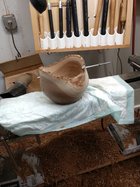There are conversations about tenon or mortise, about sizing the spigot or recess between 33 to 40% of the blank diameter, but I haven’t seen a conversation about bowl depth.
What occasions this question is that I just bought a Nova chuck and was looking at accessory jaws. For most of them, even fairly large jaws, they recommend not turning anything beyond 6 inches or so in height and not using square blanks. There are other warnings in bold such as not turning above 684 rpm.
For example, the 100 mm jaws have in capital letters: THIS METHOD MUST NOT BE USED FOR ANY WORK LONGER THAN 127 MM AS THERE WOULD BE GREAT DANGER OF WOOD TEARING OUT OF CHUCK. That’s only 5 inches for pretty big jaws.
None of their chucks are “rated” for significant height blanks or rpm.
Now I know tailstock support helps but their blank size, max rpm, and avoiding square blanks sure limit turning.
I suspect the lawyers and not the turners wrote the manual but was wondering what thoughts others more experienced than I had.
This is my first new chuck and my used Oneways had no instruction booklet, so I’ve naively turned bowls up to 14 inches in height and started sometimes with square blanks.
What occasions this question is that I just bought a Nova chuck and was looking at accessory jaws. For most of them, even fairly large jaws, they recommend not turning anything beyond 6 inches or so in height and not using square blanks. There are other warnings in bold such as not turning above 684 rpm.
For example, the 100 mm jaws have in capital letters: THIS METHOD MUST NOT BE USED FOR ANY WORK LONGER THAN 127 MM AS THERE WOULD BE GREAT DANGER OF WOOD TEARING OUT OF CHUCK. That’s only 5 inches for pretty big jaws.
None of their chucks are “rated” for significant height blanks or rpm.
Now I know tailstock support helps but their blank size, max rpm, and avoiding square blanks sure limit turning.
I suspect the lawyers and not the turners wrote the manual but was wondering what thoughts others more experienced than I had.
This is my first new chuck and my used Oneways had no instruction booklet, so I’ve naively turned bowls up to 14 inches in height and started sometimes with square blanks.

